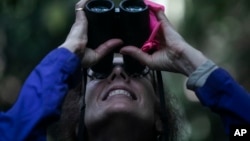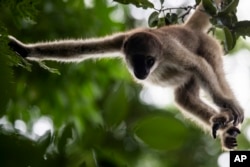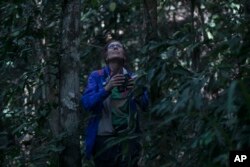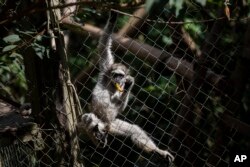Karen Strier is an American primatologist. It has been 40 years since she started studying Muriqui monkeys in Brazil. At the start, she was working on an advanced degree in anthropology at Harvard University. She continues to study the animals today.
Muriquis are the largest monkeys in the Americas. Strier first started studying them in 1983 in Brazil’s southeastern Minas Gerais state. At the time, there were only about 50 of them in a large land area 200 kilometers from the Atlantic Ocean.
The monkeys were losing their habitat, or living place, high up in the trees. Humans were cutting down the trees so they could sell their fruit and wood. As a result, the monkeys could only be found in a small area of preserved forest.
In the 1980s, many researchers centered their studies on monkeys and other primates such as gorillas in Africa and Asia. Dian Fossey and Jane Goodall were known for their studies of mountain gorillas and chimpanzees at the time.
Those women said the animals lived in a male-dominated society. Fighting was common. One male gorilla would fight another to keep control over the group or take a leadership position. Males who lost the fights would be sent away from the group.
But in Brazil, the Muriquis seemed peaceful. Strier said the male and female monkeys were the same size –about 2 meters long and around 15 kilograms. Males lived close to each other and did not fight.
The monkeys were friendly with others in the group. In some cases, the females left their living groups in search of a mate.
“I love them. They’re beautiful animals,” Strier said.
Strier said the Muriquis showed researchers that not all primates lived the same way. “I think (they) helped open that door to understanding better some of this diversity,” she said.
She does her research in the 950-hectare Feliciano Miguel Abdala reserve. The area is about 500 kilometers north of Rio de Janeiro. In the time she has followed the monkeys, their population has grown to over 230. The females can only have babies once every three years, so growth is slow.
Russell Mittermeier is a primatologist with the environmental group Re:wild. He is who first introduced Strier to the monkeys. He said not many studies last for 40 years and are of such high quality.
Strier is now working to create protected areas in southeastern Brazil where the monkeys can get around safely. That means making sure sections of forest are preserved.
She wants this to happen so the population can grow larger and so the monkeys do not disappear if there is a sickness. Several years ago, she said, an outbreak of yellow fever killed about 100 monkeys over a period of five years.
Researchers are also looking for ways to encourage mating among the monkeys. In 2020, a relocation program moved some females into a protected area where there were only two males. The effort paid off. A baby was born. Once there are 12 monkeys in the family group, they will be released into the wild.
At a recent celebration of her work, Strier told the story of losing so many monkeys to yellow fever. She said the once noisy forest became quiet in a short time because so many monkeys died.
Strier told the gathering of primatologists, environmentalists and monkey-lovers that she is always worried her life’s work could be wiped out by another sickness. She called the monkeys “fragile,” and added, “We’re not done.”
I’m Dan Friedell.
Dan Friedell adapted this story for Learning English based on a story by The Associated Press.
________________________________________________________________
Words in This Story
preserved –adj. kept safe from destruction
primatologist–n. a scientist who studies primates, such as monkeys, apes and chimpanzees
dominate – v. to control or lead using force
diversity – adj. characteristics or qualities that are different
reserve– n. an area protected by law from development or destruction
encourage –v. to make a situation right for something to happen
fragile –adj. not strong, easily hurt or damaged
_________________________________________________________________
We want to hear from you. Would you like to find a way to help the monkeys in Brazil?
Here is how our comment system works:
- Write your comment in the box.
- Under the box, you can see four images for social media accounts. They are for Disqus, Facebook, Twitter and Google.
- Click on one image and a box appears. Enter the login for your social media account. Or you may create one on the Disqus system. It is the blue circle with “D” on it. It is free.
Each time you return to comment on the Learning English site, you can use your account and see your comments and replies to them. Our comment policy is here.















Forum